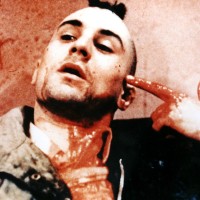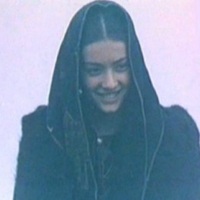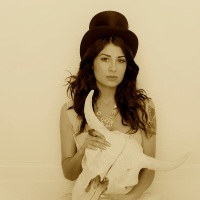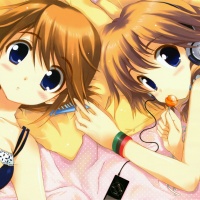Sacred Cows #5: Mystic Relaxation and Teen Fun
The late great military historian John Keegan wrote that “the Second World War is the largest single event in human history.” World War 2, while slaughtering more than 50 million people worldwide, wounding just as many and inflicting emotional damage in so many other quarters, left a crater in our world that is unavoidable and bequeathed to future generations down to the present day a form of global post-traumatic stress syndrome. It was only after the relatively contained Vietnam War that Americans began to seriously and collectively contemplate the effects of the psychic trauma that soldiers must endure in warfare. (Later the concept of PTSD was applied to other situations; rape, child abuse, car crashes, etc.) Some symptoms of PTSD include nightmares, depression, jitteriness, traumatic memories.
There is also a second set of behaviors meant to keep the starker aspects of war’s darkness at bay. These includes, avoiding reminders of what happened, drinking and drugs to numb yourself, workaholism and pulling away from loved ones who cannot understand. And this begins to sound vaguely like a cultural history in the Postwar Era.
When the war was over Americans, in general, tried to put both the War and the Great Depression behind them as quickly as possible. Europe was in much different shape and bred some its bleaker philosophical products, such as Existentialism, the Vienna Actionists, or the films of Ingmar Bergman. Yet much of what is being said about the nature of Fun with a capitol F, will eventually come even to the most historically blasted regions of Europe, and eventually even the old Iron Curtain countries to some degree. But it was in the United States of America, the least touched of the major combatants of the Second World War, that this avoidance of the past would scale heights undreamt of before. It was in America that the seeds of Fun would grow from a few past times into a major reason for living.
To be sure, America was not without its darker reflections too. American culture specializes in what Virginia Wilson, in her book The Secret Life of Puppets, calls a sub-zeitgeist. Zeitgeist is a German combination noun for the words for time (zeit) and spirit (geist, like the English ghost). It means Spirit of the Age. And the spirit of Fun, as we shall see, was indeed often the spirit of the age from the 1950s onward. But the sub-zeitgeist of that same period contained elements that we were less comfortable proclaiming out loud. So Film Noir, with its extraordinarily bleak outlook on human nature, was an immediate reaction to the pit opening beneath our feet in the 1940s. Yet this certainly was not the culture that anyone at the time wanted to point to with any degree of pride. You can see a similar sub-zeitgeist in the present when the official media must be positive, instructive, watchdogs of all politically incorrect ideologies (left or right) while beneath the zeitgeist things are seething: celebrity gossip, YouTube conspiracy rants and some of the most intense horror films ever made.
But the zeitgeist of the 1950s was adult relaxation and teen fun. Hard work? Yes. Get ahead? Without a doubt. Was there was Communist paranoia? Sure. But can’t we just get past that? Was there a Civil Rights Movement growing? Righteously. But then again can you have civil rights struggles in a broken down society? Not too easily. Were there Beat poets? Sure but there were also funny Beatniks on that crazy new TV set where Uncle Miltie and Sid Caesar dispensed laughs like Coca-Cola from a soda machine. Hollywood was making Biblical and Roman epics. America was flush with cash. People moved into those new-fangled suburbs, in their new behemoth automobiles, on brand spanking new superhighways, while visiting those new fast food burger joints. Adults barbequed steaks on their new rotisserie grills, that they pulled out of their new refrigerators, and then cleaned the dishes in that luxury of luxuries, a shiny new dishwasher. They listened to their new 33 and 1/3 speed record albums of soothing Easy Listening music or Light Classics as they were often called. And look at the covers of those records. What do you see? Reclining. Slumbering. Dreaming. Rest. ‘Fly Me To The Moon.’ And above all that mystical hope of Postwar adult stability… Relaxation. (A sacred cow that has since moved into the multitude of current self-realization techniques.)
But if you want to see the future look to the Youth. (Another sacred cow: that the Youth are always more evolved than their parents. That the future belongs to the young. I think of the Nazi boy singing ‘Tomorrow Belongs to Me’ in Cabaret.) The future of America? Teens! And I don’t just mean the teens will grow up into adults who will obviously populate the planet when all these older folks have passed on. I mean Teens as a new category for existence. I know 40 year-olds who are still Teens in 21st Century America.
It is by now a well known fact that the Teenager was essentially created in the early 1950s as a sociological category. Or rather that the Teen, in a similar, though not identical way, was created as a marketing concept much as we have recently witnessed the rise of the Tweens. Prior to the Fifties one does not notice much of a Teen culture. There were a few movies made with Judy Garland and Mickey Rooney earlier. But the overwhelming number of films in the first half of the Twentieth Century featured adult protagonists. From the early Edison days through the early Talkies kids weren’t even expected to show up at the movie palace. The pre-code talkies seem almost exclusively focused on grownups. After the code was enforced in 1934 you see the first glimmer of family friendly entertainment. (Thank you Walt Disney.)
But focus on teens? Hardly. Kids went to see the Universal horror films. They would get the East Side Kids or Little Rascals as Saturday morning fodder. But you were supposed to outgrow these things. The reason that there wasn’t much emphasis on Teens is because they didn’t really exist. Weird notion eh? It kind of flies in notion of all post-Fifties demographics. There were certainly people who were fifteen or thirteen, et cetera. But during the Thirties and the war years America was still connected to traditional modes of family, certainly far more than they are now. That meant that in your teens you were supposed to start taking on adult responsibilities. If you lived on the farm you were already working, if your family ran a little grocery store you were already helping out, you weren’t sitting at home channel surfing yet. You certainly weren’t mastering the World of Warcraft or downloading Ke$ha’s oeuvre on iTunes. If you were a girl, you were learning to cook and sew, you paid close attention to relatives who were giving birth because by the age of 19 you might already be a wife and a mother. Likewise if you were teenage boy you were expected to start thinking about providing for a family someday. Not that everyone followed these rules, nevertheless, everyone understood them.
But suddenly the Teen was invented in the 1950s. This was an adolescent who lived in an extremely affluent version of America. This child had something unheard of by previous generations: Time. And money. And they suddenly began to use these commodities. The older folks must have felt that all that Depression Era working and scrimping was something their kids wouldn’t have to do. Its almost as if the collective wealth of the American society had created the idea that all people could suck on stainless steel spoons together. If the royals of England could lounge on their well manicured lawns, then so too could the folks in Orange County, California, or even Phoenix, Arizona, just to mention two places without water. And who played on those lawns. Ironically enough it was supposed to be children. And they did for a few decades until Hula Hoops and Wham-O Water Wiggles gave way to video games and computer porn.
Meanwhile the 1950s were the halcyon days of American Teendom. There were comic books, JD novels, films like Rebel Without a Cause or The Girl Can’t Help It. Or better still: I was a Teenage Werewolf, Frankenstein and of course Caveman. Heck any sci-fi film would do. Big bugs, drive-in movies, hot-rods and convertibles, were all part of this new dream called Teenager. There was even a Broadway musical about juvenile delinquents – West Side Story.
And of course there was music: Rock and Roll. There is a bewildering explosion of small guitar oriented bands playing some of the most ecstatic and frankly fun (in the old sense) music ever made, and all for the Teens. Few people took this music seriously. Nobody thought it would last. It was a simple, quickly digestible product from the fount of American musical invention.
And though there might be emotional turmoil (see James Dean) or poetry (see Chuck Berry) or unbelievable success (see Elvis) Teenage life in the 1950s was supposed to Fun. And this became truer the more that the Baby Boomers (the silliness of the moniker betrays the whole game) aged and looked back at the malt shops and sock hops with the Fun-tinted glasses of nostalgia. There were in truth many serious sides to the Fifties. Yet in the popular imagination the Fifties are often still viewed as a time of Eisenhower era innocence or naiveté: Happy Days when you were Sweet Sixteen. (Never mind the leering quality in the voices of those older guys singing about those mythical 16 year-olds.)

Frank Sinatra, Montgomery Clift, Ernest Borgnine and other members of the From Here To Eternity cast in Classic Postwar Hawaiian Shirt Style
In the immediate Postwar Era it was supposed to be Fun Fun Fun till your daddy took your T-Bird away. But daddy was in some maitai-induced World War 2 PTSD haze at Trader Vic’s reminiscing with his cronies about their time in the Pacific. Meanwhile the new generation was winding up to expand the definition of Fun beyond all recognition.
And then someone drove a convertible Lincoln limo through the sunny streets of Dallas…
Byrne Power
Haines, Alaska
January 18, 2014
















Leave a comment